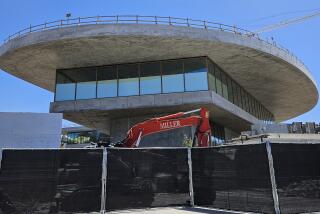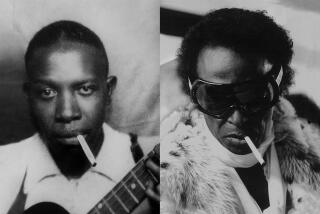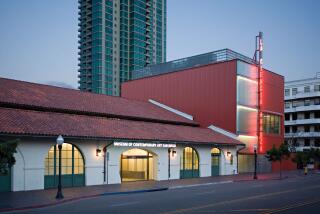Selling Andy
- Share via
More than any other artist, Andy Warhol blurred the lines between art and commerce. Best known as a Pop painter of Campbell’s soup cans and celebrity portraits--Liz, Mao, Marilyn, Elvis, Jackie--he reveled in popular culture, shopped up a storm and palled around with the rich and famous. At his death, in 1987, he left a huge body of work that captures the spirit of a relentlessly consumerist, star-struck society.
But even the artist probably would be amazed to see the marketing blitz for the “Andy Warhol Retrospective,” which will open May 25 at the Museum of Contemporary Art. For the first time, this museum has teamed up with city government, the Los Angeles Convention and Visitors Bureau, corporate sponsors and private donors to try to produce a blockbuster.
Beginning Monday, banners and billboards advertising the show will go up all over town, and they are only the most visible aspect of a sales pitch that includes hotel packages, poster giveaways and contests offering free trips to L.A.
“Much of our stock in trade is--and should be--artists that relatively few people have heard of,” said Jeremy Strick, MOCA’s director. “That’s what a contemporary art museum does. But Warhol is famous, an icon, so we can work with this exhibition in a way that is pretty unusual in the field of contemporary art.”
The participation of the convention and visitors bureau, a private nonprofit association that markets L.A. as a travel destination, is a key aspect of the plan. Building on its success with “Van Gogh’s Van Goghs: Masterpieces From the Van Gogh Museum, Amsterdam” at the Los Angeles County Museum of Art in 1999, the bureau has committed more than $850,000 to a national advertising campaign for “Warhol,” in partnership with American Express. The goal is to boost L.A. tourism--still recovering from its post-Sept. 11 plunge--the economy and MOCA’s audience and financial resources, said Robert Barrett, the bureau’s vice president of domestic marketing.
The bureau’s support--along with an unprecedented $250,000 donation to MOCA from the city--also has helped to attract corporate sponsors, whose names appear on ads for the show and who will host private viewings for their employees and clients. Merrill Lynch signed on as the principal sponsor; Angeleno magazine and Jaguar are subsidiary supporters.
The amount of their contributions has not been revealed, but that support, combined with the city’s donation and more than $1 million from private sources, will pay all costs of the exhibition, which has a budget of about $2 million, said Paul Johnson, director of development at MOCA. Proceeds from admissions (which, for adults, will be doubled or more over the regular fees) and sales in MOCA’s shop will make money for the museum, he said.
The exhibition--a 50-year overview of the artist’s work encompassing little-known drawings and prints as well as iconic Pop paintings--is the first major Warhol survey in America since 1989, when the Museum of Modern Art in New York organized a retrospective. The current show opened last fall at the Neue Nationalgalerie in Berlin and wasn’t intended to travel. But when the Tate Gallery in London managed to book it for February and March, MOCA officials launched an all-out effort to extend the tour to Los Angeles, the final stop and the only American venue.
“This is an extraordinary opportunity, art historically,” Strick said. Given the escalating value of Warhol’s work and the difficulty of persuading owners to lend pieces from their collections, there isn’t likely to be a similar show any time soon, he said. “If the works went home, they weren’t going to come back, so we had to act very quickly.”
Presenting the show is “a very expensive proposition,” Strick said. MOCA is responsible for insuring, transporting and installing the works, providing visitor services and publishing a new version of the catalog to reflect substitutions and additions of artworks in the Los Angeles presentation. The museum, which will extend its weekend hours for “Warhol,” also went to considerable trouble and expense to fit the exhibition into its long-planned schedule. A show of H.C. Westermann’s sculpture and works on paper was moved from the California Plaza facility to the Geffen Contemporary, and a show of Juan Munoz’s sculpture was postponed.
“This has put an enormous strain on our staff and supporters,” Strick said. “I think most institutions find that a steady diet of blockbuster exhibitions is not a healthy thing; it’s too rich. But this is a unique opportunity that is really our duty to pursue as aggressively as possible.” Strick is planning for crowds (a tent will be installed on the plaza to protect waiting visitors from the sun) but hoping for impact: He’d like Warhol fans to spill over into the museum’s other exhibitions and return to MOCA once the Warhol show closes.
“We absolutely want as many people to know about the exhibition and see it as possible,” he said.
Major exhibitions are usually planned three to five years in advance, but for “Warhol” MOCA had six months, once the staff determined that most of the artworks’ owners would extend their loans. “The next stumbling block was to quickly raise some money,” Strick said. “We didn’t know what the exact cost would be, but we had to have funds in place.” Within a few weeks, the museum received contributions of more than $1 million from trustees and a few other patrons, he said.
Then MOCA board chairman Bob Tuttle and other trustees made calls to garner the support of Mayor Jim Hahn and the Los Angeles Convention and Visitors Bureau.
The bureau’s help, said Strick, “has made an incredible difference.” Its “Book a Room Get Tickets” campaign offers package deals at 10 hotels from the Fairmont Miramar in Santa Monica to the New Otani downtown. Ads in Vanity Fair, the New Yorker, Travel & Leisure and the New York Times, and an eight-page “travel planner” on the Warhol show and other Los Angeles attractions, sent to 120,000 American Express cardholders, offer “two complimentary ‘Andy Warhol Retrospective’ VIP tickets that allow you to go to the front of the line, any day, any time” and an exhibition catalog to anyone who reserves a room at one of the hotels and pays with an American Express card.
Among other bureau-sponsored promotions, the May issue of Travel Holiday offers exhibition tickets and a trip for two to Los Angeles as first prize and 100 Warhol posters as second prize in a contest that celebrates the magazine’s 101st birthday. Radio spots promoting the television game show “Hollywood Squares” also feature a contest with an L.A./Warhol trip for two, including airfare and hotel accommodations, as the grand prize. All of the bounty is paid for by a coalition of bureau partners, including American Express and the hotels.
Speaking for Merrill Lynch, Anita Contini said the company was impressed by the exhibition and by the fact that the museum “very smartly rallied a lot of support first through its own constituency, its own board, and then the city and the convention and visitors bureau” before seeking corporate funds.
MOCA’s venture into the world of blockbusters invites comparisons with the Van Gogh extravaganza, which cost $10.6 million--more than five times as much as the Warhol exhibition. “Van Gogh’s Van Goghs” brought 821,000 people to the Los Angeles County Museum of Art, pushing its annual attendance from 554,000 during 1997-98 to 1.3 million during 1998-99, and pumped $122 million into the local economy, according to an economic impact study prepared after the show closed by Marey and Associates Inc., a Wyoming-based research firm.
Jack Kyser, chief economist of the Los Angeles Economic Development Corp., has estimated that the Warhol retrospective will have an even bigger economic impact on Los Angeles County--$130 million. But MOCA officials say that prediction may be overly optimistic. Warhol is a giant of 20th century art, but Van Gogh is probably the world’s most popular artist. What’s more, “Andy Warhol Retrospective” will run for 12 weeks, the usual length of a major exhibition but five weeks less than “Van Gogh’s Van Goghs.”
“We are not planning on something of the scale of Van Gogh,” Strick said. Even so, the Warhol show--which drew about 200,000 people to each of its earlier venues--is likely to set an attendance record at MOCA. Its most popular exhibition to date, in terms of average weekly attendance, is “David Hockney Retrospective: Photoworks,” which attracted 88,400 visitors over 13 weeks in 2001. “At the End of the Century: One Hundred Years of Architecture” brought 150,000 visitors in 2000, but it had an unusually long run of 23 weeks.
Dated and timed tickets to “Andy Warhol Retrospective” went on sale April 4 at Ticketmaster. The cost for adults is $12 on weekdays and $17 on weekends (it’s usually $6); for children 12 and under, usually admitted free, the cost is $6 on weekdays and $8 on weekends. The museum is also promoting sales of memberships, which include two free tickets to the exhibition.
“This is a great moment for us,” said trustee Cliff Einstein, an advertising executive whose firm, Dailey & Associates, has produced and donated the banners and billboards. “Museums are always wrestling with how to promote themselves and attract new members. A show like this is a once-in-a-lifetime experience, so we pull out all the stops. It’s a chance to show off our institution and our wares.”
More to Read
The biggest entertainment stories
Get our big stories about Hollywood, film, television, music, arts, culture and more right in your inbox as soon as they publish.
You may occasionally receive promotional content from the Los Angeles Times.










